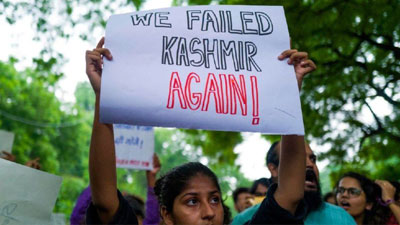Kashmir is a Himalayan region that both India and Pakistan say is fully theirs. The area was once a princely state called Jammu and Kashmir, but it joined India in 1947 soon after the sub-continent was divided up at the end of Brit-ish rule.
India and Pakistan subsequently went to war over it and each came to control different parts of the terri-tory with a ceasefire line agreed.
There has been violence in the Indian-administered side – the state of Jammu and Kashmir – for 30 years due to a separatist insurgency against Indian rule.
What’s happened now?
In the first few days of August, there were signs of something afoot in Kashmir.
Tens of thousands of additional Indian troops were deployed, a major Hindu pilgrimage was cancelled, schools and colleges were shut, tourists were or-dered to leave, telephone and internet services were suspended and regional political leaders were placed under house arrest.
But most of the speculation was that Article 35A of the Indian constitution, which gave some special privileges to the people of the state, would be scrapped.
The government then stunned everyone by saying it was revoking nearly all of Article 370, which 35A is part of and which has been the basis of Kashmir’s complex relationship with India for some 70 years.
The article allowed the state a certain amount of autonomy – its own constitution, a separate flag and freedom to make laws. Foreign affairs, defence and communications remained the preserve of the cen-tral government.
As a result, Jammu and Kashmir could make its own rules relating to permanent residency, owner-ship of property and fundamental rights. It could also bar Indians from outside the state from purchasing property or settling there.
The constitutional provision has underpinned India’s often fraught relationship with Kashmir, the only Muslim-majority region to join India at partition.
Why did the government do it?
Prime Minister Narendra Modi and the Hindu na-tionalist Bharatiya Janata Party had long opposed Article 370 and revoking it was in the party’s 2019 election manifesto.
They argued it needed to be scrapped to integrate Kashmir and put it on the same footing as the rest of India. After returning to power with a massive man-date in the April-May general elections, the gov-ernment lost no time in acting on its pledge.
Critics of Monday’s move are linking it to the eco-nomic slowdown that India is currently facing – they say it provides a much-needed diversion for the government.
Kashmiri protesters clash with government forces in Srinagar, Indian-administered Kashmir in 2018.
Many Kashmiris believe that the BJP ultimately wants to change the demographic character of the Muslim-majority region by allowing non-Kashmiris to buy land there.
Although Home Minister Amit Shah’s announce-ment in parliament on Monday came as a surprise to most Indians, it would have taken the government some preparation to arrive at the decision.
The move also fits in with Mr Modi’s desire to show that the BJP is tough on Kashmir, and Pakistan.
What’s changed on the ground?
Kashmir will no longer have a separate constitution but will have to abide by the Indian constitution much like any other state.
All Indian laws will be automatically applicable to Kashmiris, and people from outside the state will be able to buy property there.
The government says this will bring development to the region.
Hindu rightwing groups have welcomed the move
“I want to tell the people of Jammu and Kashmir what damage Articles 370 and 35A did to the state,” Mr Shah told parliament. “It’s because of these sec-tions that democracy was never fully implemented, corruption increased in the state, that no develop-ment could take place.”
The government is also moving to break up the state into two smaller, federally administered territories. One region will combine Muslim-majority Kashmir and Hindu-majority Jammu. The other is Buddhist-majority Ladakh, which is culturally and historically close to Tibet.
P Chidambaram, a senior leader in the opposition Congress Party described the decision as a “catas-trophic step” and warned in parliament that it could have serious consequences.
“You may think you have scored a victory, but you are wrong and history will prove you to be wrong. Future generations will realise what a grave mistake this house is making today,” he said.
According to the constitution, Article 370 could only be modified with the agreement of the “state government”. But there hasn’t been much of a state government in Jammu and Kashmir for over a year now.
In June last year, India imposed federal rule after the government of the then chief minister, Me-hbooba Mufti, was reduced to a minority. This meant the federal government only had to seek the consent of the governor who imposes its rule.
The government says it is well within its rights to bring in the changes and that similar decisions have been taken by federal governments in the past.—KMS










